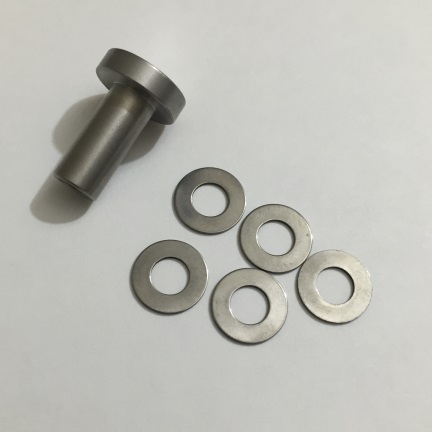by Larry Connelley
In many folding knives, a single bushing (or washer) is used in the pivot to provide smooth rotational movement of the blade. Many knifemakers have chosen to use bushing materials like teflon, nylatron, nylon and phosbor bronze to reduce metal on metal friction and the possibility of galling. Galling is a specific metal on metal sliding friction, this adhesion at the atomic level will cause damage to the metal surfaces. Some bushings in knives have been improved by adding perforations in the bushings, these perforations reduce surface area therefor reducing friction and can hold lubricant.

Some newer knives however are more frequently utilizing bearing pivots of all kinds, in order to improve blade deployment. Before we get into the types of bearings, here is the run-down on the advantages and disadvantages to bearing pivots, and the differences in bearing types.
Terminology
Ball Bearing - a circular ball that is designed to roll in between to surfaces, materials may vary.
Race - an area were the ball bearings move and make contact with the two surfaces. A hardened steel race can be used to reduce wear on surfaces that that are not hardened, like titanium or other handle materials and reduce wear from the concentrated pressure and friction.
Cage - an optional housing for the bearings to move while keeping the bearings in a fixed position. Can be made of various materials and designs.
Thrust bearing - a cylinder, instead of a ball, that is designed to roll in between two surfaces.
The Pros and Cons to Bearings
Friction Reduction - Bearing pivots are built into knife pivots because they greatly reduce friction when opening and closing the blade. Often times bearings are used on knives that have flipper openers. Bearings reduce metal-to-metal contact, resulting in quick, fluid deployments of the blade each time it opens or closes. Put simply bearings reduce friction.
Maintenance - the disadvantages of bearings include their need for considerable maintenance and care. Knife users must make sure to lubricate and clean the bearings, while using closures to keep them free from dirt and debris. In addition, carbon steel bearings can rust and degrade.
Wear - It is possible that bearings eventually wear down either the bearing or the race. The softer of the two materials will wear down first, the bearing or the bearing race. Also, without adequate engineering and bearings torsional strength can be lacking.
Thickness - Bearings can also require the use of races. Races are the surface where the bearings move to reduce wear. The requirement to have races can require a thicker housing in the knife handle than using a bushing. However, there are many different types of knife bearing system, each one with different strengths.
Cost - high quality bearing systems can increase the cost of a knife.
Types of Bearing Pivots
The most common types of bearing pivots in knives include:
The Ball bearing pivot (open): Also known as an uncaged ball-bearing pivot system, this type of bearing uses open ball bearings at the blade pivot. The balls are held in place in machined reliefs in either the blade or the handle. A knife using this type of bearing includes the IKBS bearing pivot. The bearings are loose, inside of the releaf and there is generally not a race.
The Caged Ball Bearing (ball bearings in a housing): This system uses fewer balls than the equivalent open bearing pivot held in a cage (structure), making maintenance easier.



Thrust Cylindrical Roller Bearings: Uses cylinders instead of balls, these bearings create more friction, yet there is more stability under torsion.
Multi-row bearing: This system uses caged, multiple rows of bearings which provides more stability under torsion. An example of a knife using this type of pivot system includes some of Shirogorov models .
Overall, bearing pivots can deploy a knife with agility and smooth release. Though they do require some service and maintenance. Keep in mind that this technology has its pros and cons. If you need a low maintenance, no fail pivot, we recommend a standard bushing. If you are prepared to clean lubricate and keep your knife free from debris, a bearing pivot can provide extremely fast reduced friction opening that is particularly useful with flipper folders.
Value Added Article Produced by KnifeArt.com. If you enjoy the article and it helps in your knife knowledge, we would love to have you as our customer. Links and social shares also appreciated.
© Copyright - All rights reserved
